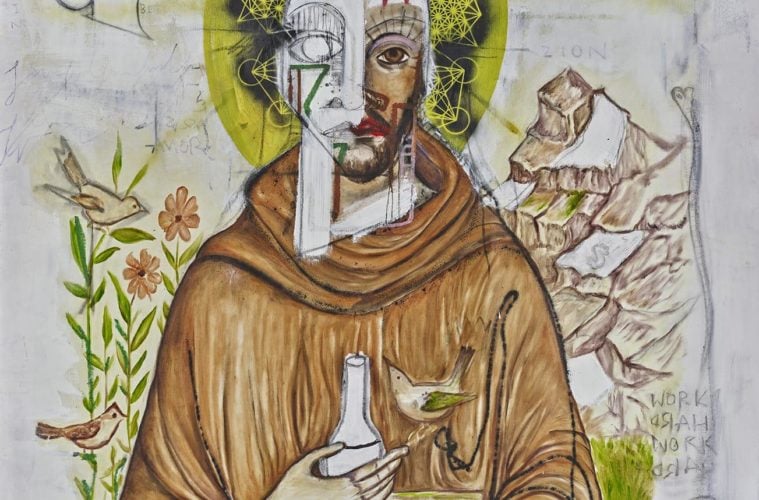*Brand Partner Content*
For contemporary artist Louis Carreon, veering off the path of living a traditional life is a notion he knows all too well. From a young age, the artist found himself defying the standards set by society when he began running with an influential neighborhood gang out of Long Beach, California. The lure of living on the edge quickly became irresistible to Carreon. With a knack for creativity and a prolific sense of artistry, the young mischief-maker found use for his creative lane in graffiti art to tag more than just freeways and buildings. Soon Carreon found himself chasing the high of rebellion and as a result, would later end up serving a two-year federal prison sentence for drug crimes. After a sobering revelation and years of redemption, Carreon redirected his efforts and energy into creating real art.
But in true Louis Carreon fashion, his style of art did not conform to the expectations of a pretentious art world. He chose a specific and nearly uncharted controversial style, caring less if people would accept it. Fortunately, it was so off base that Carreon’s contemporary religious iconography captured the attention of prestigious gallery owners, art academia, and collectors globally.
Since the genesis of his career, his narratives and his religious iconography art has only matured, and additionally has since merited more value per painting, particularly over the last five years. Today, the artist has amassed a growing base of dedicated art collectors, all over the world.
“When Brian Keenan, the manuscripts curator of The Getty museum messages me saying, ‘I love that body of work,’ or when Dr. Ori Z. Soltes, a professor at Georgetown University with expertise in biblical narratives and art history, messages me about my paintings or uses my work in a lecture, that is where I get my fulfillment. That is what I am after,” Carreon says. “I don’t care if my art never sells again. I am here to create a dialogue about the greats and hope that it serves a purpose in history classes in the future.”
Now, after nearly a decade of growing success in contemporary art, Carreon has spiced up his life yet again. Though the emerging artist believed he would always remain in his creative pocket, opportunities to break boundaries called his name.
“I was painting in my studio, and my homie Cameron Mitchel from Curated By Media called. Cameron has been trying to get me to act for a lifetime, and he made me an overture. He said, ‘I think you should come down to the office and read for this role in this new film Paydirt.’ I was like, ‘No, brother, I’m good, but I love you,’ and he reverted that Val Kilmer is the lead and it’s a good role. Val Kilmer has always been one of my favorites, so that made me reconsider. I went down to the office and met with the director, and it worked out, and with life experience, I already knew this role in my spirit. The rest is history.”
The role of a Mexican cartel enforcer and right hand to ‘el Jefe’ was a dip back into Carreon’s former self and an adrenaline opportunity he could not pass up. Carreon’s jagged path continues to open doors for the artist and has proven that conformity is merely a suggestion.
We recently sat down with Louis to find out exactly how the exciting opportunity came about…
Given the precipitous rise your art career has seen, are you still surprised (or not) to see new opportunities open up for you in other creative areas, such as acting & fashion?
Louis: I believe as a creative when you pour your spirit into your work for long enough, and industry leaders recognize that through your passion, relentlessness, and dedication to your art form you’re prevailing, then yes, I think people may put their money on you creatively because they know you’ll be a sure thing at what you set your mind on creatively. True artists will understand this mind state. As far as acting is concerned, growing up in LA, I watched my friends get famous, and with attention, the ego changed them for the worse. So the thought of being recognized for anything artistic that can change your life in Hollywood always tripped me out, so I kept painting.
Given how successful your art is becoming on a cultural level, do you think you’re at risk of spreading yourself too thin to maintain the same level of connection you currently have with culture?
Louis: I’m a firm believer that you can’t look and think about imaginary lines in culture drawn by strangers. I’ve been painting for 20 years because I love it, and it’s a great outlet for my emotions. I think culture will gravitate towards authenticity, and the patterns I move in keep me in a humble and raw space. I think exploring other art fields only expands personal depth as one overcomes the fear or apprehension attached to it.
What is the true level of impact you see yourself reaching, and how do each of these various mediums play a role in delivering that cumulative effect?
Louis: I don’t test myself with levels; I believe all art forms are personal journeys, and growth is the driving aim. Whether painting or engaging in any other form of creativity, I’ll obsess over it, and it will control me until it doesn’t anymore.
Advertising disclosure: We may receive compensation for some of the links in our stories. Thank you for supporting LA Weekly and our advertisers.

